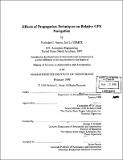Effects of propagation techniques on relative GPS navigation
Author(s)
Nuzzo, Nicholas C. (Nicholas Christopher), 1974-
DownloadFull printable version (7.461Mb)
Other Contributors
Massachusetts Institute of Technology. Dept. of Aeronautics and Astronautics.
Advisor
George T. Schmidt.
Terms of use
Metadata
Show full item recordAbstract
Various service vehicles are being developed to resupply the International Space Station (ISS). These service vehicles and the ISS will perform automated space rendezvous. The performance of a relative GPS navigation filter for this application is presented. Specifically, the effects of four different techniques for propagating the filter state are demonstrated and evaluated. These techniques include, (1) integration of the equations of motion accounting for J2, J3, J4 and aerodynamic drag, (2) first-order equations of relative motion that account for the effects of J2 and include a second-order conic approximation, (3) the Universal Keplerian state transition matrix, and (4) the use of the Clohessy-Wiltshire equations of relative motion. GPS measurements were simulated and included errors due to Selective Availability, clock bias, clock drift, and receiver noise. The relative navigation filter used pseudorange and delta-range measurements to estimate the filter state which included the relative position and relative velocity between the vehicles conducting the space rendezvous. The results demonstrated that all four techniques surpassed the performance requirements on relative position and velocity errors. However, integrating the equations of motion, technique (1), resulted in the best performance. The filter state errors for this technique were the smallest and remained within the 3 [sigma] covariance bounds for all the cases studied. Effects due to eccentricity were observed in the remaining propagation techniques with the worst noted in technique (4). The most significant perturbation was shown to be J2, producing significant propagation and filter errors when the state was being propagated by methods (3) and (4), which did not account for it.
Description
Thesis (S.M.)--Massachusetts Institute of Technology, Dept. of Aeronautics and Astronautics, 1999. Includes bibliographical references (p. 173-176).
Date issued
1999Department
Massachusetts Institute of Technology. Department of Aeronautics and AstronauticsPublisher
Massachusetts Institute of Technology
Keywords
Aeronautics and Astronautics.